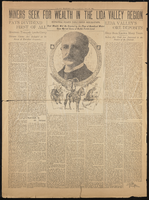Search the Special Collections and Archives Portal
Search Results
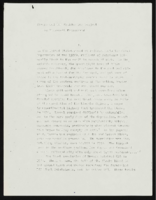
"Blacks and the Boulder Dam Project": manuscript draft by Roosevelt Fitzgerald
Date
Archival Collection
Description
From the Roosevelt Fitzgerald Professional Papers (MS-01082) -- Unpublished manuscripts file.
Text
JMA Architecture Studio Records
Identifier
Abstract
The JMA Architecture Studio Records are comprised of architectural records (1953-2002) created by the American architect Jack Miller and/or his architectural firm, known as both Jack Miller & Associates, Architects, & Engineers, Inc and JMA Architects, Inc. This collection includes 30.25 linear feet of materials documenting work on over 250 projects. The collection focuses on Las Vegas and Reno, Nevada. The materials feature photographs of the firm’s projects and hand-drawn architectural drawings, ranging from pencil and ink on tracing paper preliminary sketches to ink on Mylar (TM) construction documents. The drawings also contain work from a number of consultants, engineers, and other architects who collaborated on the development of the various projects. The collection includes architectural drawings for hotels, casinos, integrated casino resorts, office towers, multi-family residential developments, and custom single-family homes.
Archival Collection

Transcript of interview with Robert D. Howell by Joe Sant, February 26, 1977
Date
Archival Collection
Description
On February 26, 1977, collector Joe Sant interviewed local Nevadan business owner, Robert D. Howell (born November 22nd, 1939 in Las Vegas, Nevada) in his home in Las Vegas, Nevada. This interview covers Las Vegas in the old days, from Mr. Howell’s personal experience of being born and raised in Nevada. During this interview, Mr. Howell also discusses the early above ground atomic tests, local environmental and social changes, the economic landscape, the Mormon Fort, religious beliefs, and local recreation. The interview concludes with discussion on air pollution.
Text

Transcript of interview with Russell Grater by Frederick Dougan, February 10, 1977
Date
Archival Collection
Description
On February 10, 1977, Frederick Dougan interviewed Russell Grater (born 1907 in Lebanon, Indiana) about his career in the U.S. National Park Service. Grater first talks about his move to the Southern Nevada area and his work that impacted the Hoover Dam project. He then talks about the town of St. Thomas, Nevada, the Lost City, and the activities of tourists. Grater also talks about his work in excavation, the indigenous American Indian tribes of the area, findings on petroglyphs, and the types of wildlife that were found in the area. He later talks about findings related to fossils, gold mining, the effects of World War II on the dam project, and vegetation in the area.
Text

Transcript of interview with Lamar Foremaster by Gregory Hall, February 14, 1979
Date
Archival Collection
Description
On February 14, 1979, Gregory M. Hall interviewed his coworker, LaMar Foremaster (born May 9th, 1907 in Alamo, Nevada) at his place of business, Anderson Dairy, in Las Vegas, Nevada. This interview covers the changes, growth, and development of Southern Nevada from 1907 to 1979. During the interview LaMar discusses the Old Ranch, Boulder Dam, Hoover Dam, Fremont Street and the Strip. He also talks about his religious ties to the Mormon Church and his political activities in Las Vegas.
Text
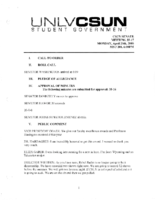
Meeting minutes for Consolidated Student Senate, University of Nevada, Las Vegas, April 25, 2005
Date
Archival Collection
Description
Text
North Las Vegas Bicentennial Committee Photographs and Drawings of Kiel Ranch
Identifier
Abstract
The North Las Vegas Bicentennial Committee Photographs and Drawings of Kiel Ranch document the buildings on Kiel (Kyle) Ranch in 1974. As part of the commemoration of the United States bicentennial, the North Las Vegas City Council elected to restore Kiel Ranch, which was one of the first non-indigenous settlements in the Las Vegas Valley. The materials include black-and-white photographs of Kiel Ranch as it was in 1974 as well as architectural drawings of planned renovations to the main house, the Brown House, the foreman's house, and the ranch hands' house.
Archival Collection
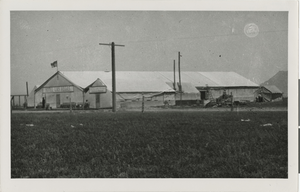
Photograph of the Hotel Las Vegas (Las Vegas), 1905
Date
Archival Collection
Description
The Hotel Las Vegas was the first hotel in Las Vegas, a tent set up for people who came to participate in the land auction. Managed by Pop Squires." Transcribed from back of photo: "Hotel Las Vegas 1905. Hotel Las Vegas, built by Las Vegas Trading Co. in 1905 was located on North Main Street between Stewart and the creek across from Woodards Down Town Camp on grounds later occupied by Elwells Ware House. All canvas and lumber used in building was cut to size and holes bored in Los Angeles, ready to be bolted together on arrival in Las Vegas. Hotel had 20 rooms. Floor space was 40 x 130 ft. Kitchen and Dining Room are seen next door to Hotel on the right. This Hotel was managed by Chas. P. Squires. Photo by Eddie Gillette, 1905." Transcribed from Special Collections sheet: "Selling of L.V. First L.V. Hotel pic cap. First Las Vegas Hotel -- The Hotel Las Vegas was made ready for the first buyers of real estate at the 1905 auction when the Las Vegas Trading Co., managed by Charles (Pop) Squires, opened the registry. All canvas and lumber used in building was cut to size and holes bored in Los Angeles, a prefab forerunner. Hotel Las Vegas boasted 20 rooms and was regarded as the top 'night spot' of its day."
Site Name: Hotel Las Vegas
Address: 1 Fremont Street
Image
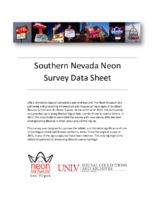
Joker's Wild Casino Neon Survey document, August 20, 2017
Date
Archival Collection
Description
Site address: 920 N Boulder Hwy
Sign owner: Boyd Gaming
Sign details: Opened 1990 as Cattle Baron Casino, closed and reopened at Joker's Wild 1993.
Sign condition: 5 - well maintained sign
Sign form: Super Pylon, and on top of building.
Sign-specific description: Neon Jester's hat on top of the Pylon sign, with a casino sign below and a reader board below that. Large neon Jester's hat on top of the Building. "Jokers Wild Casino" wrapping part of the building also in neon.
Sign - type of display: Neon
Sign - media: Steel
Sign - non-neon treatments: Reader board and LED
Sign animation: Chase with light bulbs around outside of the cabinet that houses the property name.
Sign environment: On Boulder Highway in Henderson surrounded by empty lots and small residential areas.
Sign - date of installation: c. 1993
Sign - thematic influences: The property uses the joker playing card theme. This time is used with several other casino properties throughout the Las Vegas Valley.
Survey - research locations: Boyd Gaming website, assessor's website
Surveyor: Wyatt Currie-Diamond
Survey - date completed: 2017-08-20
Sign keywords: Pylon; Neon; Steel; Chasing; Reader board; Video screen; Porte-cochère
Text

